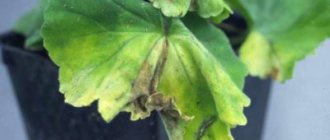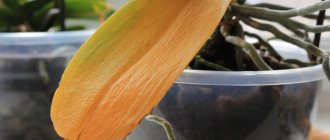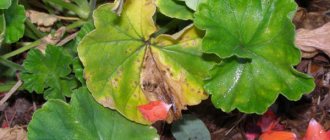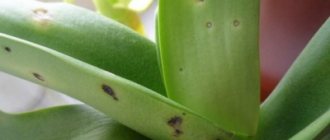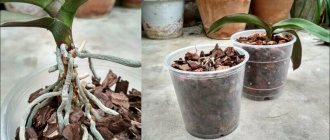The Decembrist's leaves and branches are falling - what could be the reason? What to do?
I don’t know why you didn’t respond to my comment, but I asked not out of idle curiosity, but out of a desire to help.
In order to find the cause of the disease and help the plant, you need to know its scientific name and the conditions under which it grew before the disease. A photo of the plant will be a good help in making a “diagnosis”. You personally come to see the doctor and talk in detail about what hurts, and do not tell him over the phone: “My stomach hurts. What to do?". “Decembrist” is most often called the epiphytic cactus Schlumbergera, although this plant can be confused with a variety of hatiora and ripsalidopsis. Although caring for one or another type of epiphytic cacti is generally similar, you need to know the exact name. The entire ground part of Schlumbergera is segmented shoots; there are no leaves.
“Leaf fall” of Schlumbergera can be caused by excessive dampness, especially in combination with a lack of light, transplantation into a pot for growth, periodic drying out of the soil followed by abundant watering. At the moment, it is not clear what the composition of the soil is, the frequency of watering, the level of lighting?
I'll tell you briefly about caring for Schlumbergera. The soil should be loose with the addition of a small amount of sand, pieces of charcoal, perlite (approximate composition), when replanting the pot is a little larger than the root ball by a couple of centimeters.
Water this cactus when the top layer of soil dries by about 1-2 cm, provided there is good lighting. During the period of active growth, especially in summer, stagnation of water at the roots (you cannot leave water in the pan for a long time), drying out of the soil. Watering is done so that all roots get water.
During the dormant period, in order to lay buds, the frequency of watering is reduced until the soil dries almost to the very bottom at a reduced temperature. A dormant period is arranged in early spring or autumn for healthy plants to set buds.
Only feed healthy plants with fertilizer for flowering plants or special fertilizer for cacti and succulents on moist soil.
Lighting should be bright, diffused. This cactus will do well opposite the south window, about a meter away from it; ideally, an east or west window would be suitable. Schlumbergera is afraid of the spring and summer scorching sun, but also does not tolerate partial shade and especially shade.
In your case, I would root several segments of small disposable cups in soil with perlite, if they are not thinned, but rather juicy and green. It is worth propagating the plant just in case the mother plant is on the verge and may die.
And the mother plant should be transplanted into a smaller pot, if necessary, at the same time inspect the roots for the presence of rot (it will have to be cut off), cancel fertilizing, adjust watering, increase lighting. If the lighting was low, then increase it to bright diffused light gradually. When watering, it is worth adding a couple of drops of the Zircon preparation to the water, and treating the leaves with a fungicidal agent (Skor, Hom, Topaz) against a possible fungal disease.
Why do the leaves of the flower turn red, what should I do?
Errors in content
If the leaf blades turn red, the following factors may be the cause:
- Lighting .
Zygocactus does not like bright lighting. It should be shaded from direct sunlight. It will be enough if your window is covered with tulle. When choosing which window your flower will display on, give preference to the eastern and western sides. And only in particularly hot times, transfer it to a window facing the north side. - Excessive watering . Excess moisture can also cause leaves to turn red. Between waterings, the top layer of soil in the pot should dry out.
- Incorrect feeding . The reason for reddening of the leaves may lie in a lack of nutrients, especially phosphorus. During the period of active shoot growth, you can alternate mineral fertilizers with organic ones.
Many gardeners fell in love with Schlumbergera because of the species diversity and ease of growing Christmas tree. Ripsalidopsis, which is very similar in appearance, is often mistakenly attributed to it. What are the differences between zygocactus and other similar plants, as well as what types and varieties there are, read on our website.
Decembrist has problem leaves - what could be the reasons?
If the leaves of the plant become limp, then this is an alarming symptom. This condition can be provoked not only by the diseases of the Decembrist, but also by other factors. In this case, it is necessary to immediately take urgent measures to save the flower. You need to act depending on the main reason that could lead to the loss of turgor.
Decembrist's flaccid leaves are a sign that cannot be ignored
- root rotting;
- development of diseases;
- pest damage;
- inappropriate growing conditions.
After you can find out why the Decembrist flower withers at home, you can begin treatment. Therefore, every gardener should know what to do in a given situation, and what additional signs there may be.
Why does the Decembrist have soft and limp leaves?
Decembrist is a thornless cactus, which got its name due to the beginning of flowering on the eve of the New Year holidays. The potted plant does not require care at home.
But when it is systematically violated, flower growers note flaccid leaves of the Decembrist plant. Often the reason is excessive watering and the development of fungal diseases.
If you do everything correctly in compliance with the agrotechnical requirements of cultivation, then there will be no problems with the plant.
Features of the plant
Decembrist is a plant with an epiphytic type of development. It is attached to the branches of shrubs and tree species. On the windowsill it thrives in the substrate, having a weak root system.
Beginning flower growers, looking at the articulated thickenings of the stem, mistake them for leaves.
Thanks to the “isthmuses” between the fleshy segments of the shoots, the bush has a spreading appearance - the flower is used as an hanging plant.
During the flowering period, which occurs in the second half of December, funnel-shaped, star-shaped inflorescences bloom at the ends of the branches. The petals are arranged in several tiers. The color is often pink, but sometimes the buds are also white. Decembrist blooms profusely, which attracts many gardeners who decide to cultivate it in a pot.
Causes of leaf lethargy, how to save a flower
Decembrist shoots can become soft or wither for two main reasons: the development of infection, missing roots. Infection of a plant with phytium and late blight leads to a loss of connection between the underground and above-ground parts. The main reason is a violation of the irrigation system.
Infections
The exotic flower, better known to science under the name “schlumberger,” is undemanding in comparison with other tropical plants.
If the shoots of a potted crop have become soft, the reason is most likely due to infections from which it has been suffering for a long time. The common diseases phytium and late blight affect the base of the root.
As a result of watering, the substrate becomes wet, but moisture never reaches the shoots.
In case of mild damage, you can save the flower by treating it with a fungicide solution - “Fitosporin”, “Skor” and other preparations of similar action. If the infection has been developing for a long time, the Decembrist plant is transplanted into a fresh substrate. The latter is pre-calcined in the oven for disinfection. And then the flower is sprayed with an appropriate pesticide to protect against diseases.
For your information!
Pesticide treatments are carried out outdoors in calm weather. The soil must be covered with foil or other handy material.
The roots are rotting
If infections are excluded, but leaf lethargy is evident, the cause may be waterlogging. Especially in cold temperatures, due to frequent watering, the substrate begins to turn sour, the roots rot, and the leaves do not receive the necessary nutrients.
The development of rot is evidenced by the instability of the Decembrist in the pot. Other negative factors are heat (the roots rot), excess fertilizer (high concentration literally burns the underground part).
To restore the flower to health, it is necessary to revise the rules of agricultural technology for growing Schlumberger.
Proper care
Decembrist on the windowsill is a spectacular plant that produces its bright inflorescences throughout the Christmas holidays. In order for the shoots to remain healthy and fleshy, it is necessary to organize the correct watering and fertilizing systems, and systematically inspect the flower for the presence of harmful organisms.
Lighting and temperature
The flower naturally grows in the lower tier of the jungle - at home it needs abundant, diffused color. To ensure that it develops proportionally and blooms on more than one side, it is systematically rotated. The Decembrist is not picky about temperature and can withstand a drop in the mercury column to 0 °C. The maximum critical temperature is 36 °C.
Watering and fertilizing
Moisten the Decembrist moderately after the surface layer has dried. Most of all, a flower needs moisture during the budding and flowering phases. The humidity level in the room is raised by placing a container of water next to the plant. The crop is fed only during the active growing season twice a month using potassium-phosphorus fertilizers. Their concentration is halved.
Pest Control
The Decembrist has a strong immune system. However, if there is excessive drought, the shoots are colonized by spider mites. The pest feeds on the sap of the stems. Good prevention is systematic spraying of the crown, a warm shower (acceptable before the formation of buds). In case of heavy infestation, the flower is sprayed with an insecticidal solution according to the instructions indicated on the product packaging.
Decembrist is a profusely flowering plant. To avoid the problem of lethargy and soft shoots, it is enough to follow simple care measures.
Subscribe to our channel in Yandex.Zen! Click “Subscribe to channel” to read Otomatah.ru in the Yandex feed
Source: https://otomatah.ru/pochemu-u-dekabrista-myagkie-i-vyalye-listya.html
Diseases
If the rules of care are not followed, the plant’s immunity is significantly reduced. Against this background, its susceptibility to the effects of infections that can be transmitted through soil increases.
Common diseases that can cause loss of turgor and lead to the Decembrist beginning to shed its leaves:
- Late blight. The disease is characterized by the appearance of brown-gray spots on the lower leaf segments of the Decembrist plant. Their characteristic difference is the presence of a white border along the edge. Gradually, the spots increase in size, and the disease spreads from bottom to top. As a result, nutrients do not flow from the root to the top of the flower, since the affected areas are not able to perform their function. This leads to the fact that the leaves do not receive nutrition and become lethargic. An additional sign of the disease is massive loss of segments.
- Fusarium. The causative agent of the disease is the Fusarium fungus. It penetrates into open root wounds from contaminated soil during transplantation. Fusarium consists of highly branched mycelium that penetrates plant cells. Initially, the disease affects small root processes, then switches to large ones. Subsequently, the disease affects the root collar and reaches the leaves. The lower ones become sluggish, and the upper ones appear watery along the edges. Some areas take on a light yellow tint. At low temperatures (about +16 degrees), the disease spreads quickly. The fungus releases toxins that provoke browning and complete drying of the leaves of the Decembrist.
A characteristic sign of damage is the destruction of the root collar of the plant.
- Pythium. This disease is transmitted through contaminated soil. As a result of development, the root collar rots. Pythium is most often the reason why Decembrist does not grow and its leaves become limp. With further development, brown spots appear on the plates, and the affected segments fall off. The disease progresses at high humidity and temperatures of +26..+30 degrees.
- Bacterial rot. When infected, a brown, weeping spot forms at the base of the plant, which subsequently spreads up the stem. As a result, metabolic processes in tissues are disrupted, nutrients and moisture cannot reach the leaves of the plant. They begin to wither sharply and then fall off.
Why is the crown sluggish and soft?
Infections
These diseases oppress the base of the root system. This leads to a loss of connection between the above-ground and underground parts of the plant.
It seems to a florist that if he waters and fertilizes a flower, it means it should bloom and develop. But the whole problem is that only the roots are moistened, but the moisture does not reach the above-ground part. All these factors cause not only the withering of the leaves, but also the slow death of the plant as a whole.
Symptoms of infection can include more than just limp leaf blades.
To the signs of an infectious disease, you can also add the falling off of parts of the Decembrist , as well as the blanching of the leaves or even the transformation of their green pigment into grayish.
(But do not confuse the burning of leaves in the bright sun.) Often, late blight and pythium diseases are accompanied by spider mite damage. This process is easily recognized by the rusty pigmentation on the leaf plate. The spots may be accompanied by the death of buds.
How to distinguish it from other ailments?
In order to figure out what exactly caused the leaves to wilt, you need to carefully examine the entire root system of Schlumbergera. When infected, only the tops of the roots rot, and in all other cases we are dealing with rotting of the deep central rhizomes.
Treatment
First of all, it is worth saying that the plant needs to be inspected as often as possible. Then you will be able to notice the infection in the early stages, which will help you cope with ailments without much loss. If the leaf blades have just begun to die due to infection by infectious diseases, then it is necessary to immediately treat them with fungicidal preparations. The most popular of them:
Pests
Pests can also cause wilting and falling leaves. They feed on the sap of the plant, so the flower slows down and stops blooming.
Spider mite
This pest is difficult to see with the naked eye. The provoking factor for reproduction is dry air and elevated temperatures. The lesion can be recognized at the initial stage by small light dots along the edge of the segment. Subsequently, the affected leaves become covered with a thin cobweb and lose turgor.
Attention! Most often, the pest becomes active in winter, when the central heating is turned on, or in summer during hot periods.
To treat Decembrist affected by spider mites, it is necessary to use drugs such as Fitoverm, Actellik. The treatment is carried out by spraying the above-ground part. This must be done twice every 7 days.
Mealybug
This is a harmful white insect 3-7 mm long. Damage to a flower can be recognized by the appearance of a light fluffy coating at the junction of the segments. Also, the Decembrist's growth noticeably slows down, the buds wither and fall off, and brown or red spots appear on the opened flowers.
During the life of the mealybug, sticky mucus forms on the leaves of the plant, which becomes covered with a white coating. Against this background, the leaves become lethargic and may fall off, as their metabolic processes slow down.
To get rid of the pest, it is necessary to take comprehensive measures. To do this, it is recommended to spray the leaves and stem of the plant with any of the following preparations:
It is also recommended to pour the working solution into the soil mixture in the pot. Treatment must be carried out three times at intervals of 7-10 days.
Sometimes a mealybug can be found at the base of a flower, as it leaves oviposition in the top layer of soil
In case of mass reproduction, hot water helps eliminate the problem. To do this, you need to remove the plant from the pot. Then rinse with running water at a temperature of 45-50 degrees, additionally manually remove pests and thoroughly wash the root system from the soil.
After this, soak the Decembrist completely in the insecticide solution for a couple of hours, allow it to dry, and then plant it in a new substrate.
Shchitovka
The pest begins to actively reproduce at high humidity combined with moderate temperatures. It can be found on the underside of the leaves and along the main stem.
The scale looks like a small brown bump that can be easily removed with a fingernail. As a result, yellow spots initially appear on the leaves, and subsequently they fade. In addition, the affected flower drops its buds and stops growing. If left untreated, the Decembrist withers completely.
Important! Most often, the scale insect attacks the plant in the fall, so during this period it is necessary to carefully inspect the Decembrist.
To save a flower when pests appear, it is necessary to completely remove the wilted leaves and then treat the plant with Fitoverm, Actellik. And additionally spill the substrate with Aktara working solution (1.4 g per 6 liters of water). The plant must be treated twice every 7 days.
Problems in growing Decembrist and their solution
When growing Decembrist, like any other indoor plant, it is important to know and follow the basic rules of maintenance, balanced watering, and be able to properly feed the plant, propagate it and replant it.
But compliance with almost all conditions sometimes cannot protect a flower from the harmful effects of infections and pests. To understand what to do and how to save the zygocactus, you need to establish the cause of the disease. The condition in which the plant appears to die can manifest itself in different ways and be triggered by many factors.
Withered leaves
If the Decembrist withers, the leaves on it have wrinkled and become soft, then this is one of such manifestations.
The most common causes of this condition are the following factors:
- finding the flowerpot near radiators from which dry hot air emanates;
- unbalanced watering of the Christmas tree: both a lack of moisture and its excess negatively affect the condition of the zygocactus;
- lack or excessive abundance of lighting in the growing area;
- fungal diseases;
- damage to the root system;
- death of roots due to watering with cold water at low air temperatures, significant overheating in the sun or fertilization with highly concentrated fertilizer.
Systematic spraying of Decembrist, placing it in a place with more suitable growing conditions and periodically replacing the soil in which it is grown can help avoid such symptoms.
Important! Staying the Decembrist plant in a dark place for approximately 24 hours before setting buds will help reduce the risk of the plant wilting.
Thin leaves
Sometimes Decembrist is characterized by the presence of thin leaves. This can be caused by the presence of parasites in the soil mixture and a lack of nutrients necessary for the harmonious development of plants.
To eliminate and avoid this fact in the future, you need to periodically replant the flower in new soil, feed it with mineral and organic fertilizers, and pay more attention to balanced watering.
The leaves are turning yellow
Often, due to insufficient levels of air and soil humidity, yellowing of the Decembrist leaves occurs. To avoid this, you need to take the issue of watering more seriously and help increase the level of air humidity in the room.
Systematically spraying the Christmas tree with warm water from a spray bottle will help reduce the negative impact of factors that provoke yellowing.
A lack of trace elements and other nutrients in the soil can also cause yellowing of zygocactus leaves. To restore the normal state of the Decembrist, the soil should be fertilized with mineral and organic additives.
Also, the appearance of yellow leaves on a flowerpot is possible due to its infestation with scale insects.
The leaves are falling
The Decembrist never drops its leaves without reason.
Most often they fall off due to the occurrence of provoking factors, which include:
- damage to the plant by pests (spider mites and others), which can be eliminated by a thorough inspection and treatment of the flowerpot with special preparations;
- lack of nutrients , which can be eliminated by spraying with fertilizers for epiphytic cacti or completely replanting the plant into a different soil mixture;
- stress suffered by a Christmas tree as a result of a sharp change in temperature, draft, very low level of air humidity, untimely transplantation. Normalizing the condition and conditions of plant maintenance will help eliminate the consequences.
Find out how to properly plant and care for Decembrist.
The plant is drying up
Decembrist with signs of drying out is most often found in conditions of lack of regular watering and low levels of indoor air humidity. Zygocactus also dries out due to being under the scorching rays of the sun or near heating appliances.
Normalizing the watering process, increasing air humidity, and placing the flowerpot in more suitable conditions - in a lighted but shaded place without constant access to hot air - can help correct the situation.
The roots have rotted
When caring for a Decembrist, you can sometimes observe the following symptoms:
- individual segments begin to fall off;
- shoots brighten;
- leaves and stems soften;
- buds and flowers take on a soggy appearance;
- the soil around the plant turns sour.
These are sure signs of rotting roots of the Decembrist.
This process is provoked by:
- excessive soil moisture;
- presence of stagnant water in the stand;
- watering plants with cold water.
To fix the problem you should:
- remove damaged segments to healthy areas as soon as possible;
- clean the roots from the soil and rinse them under running water;
- eliminate affected shoots of the root system that differ from healthy ones in color and the presence of delamination;
- Sprinkle healthy parts of the root with charcoal powder;
- if there are much fewer healthy roots than there were before the damage, you need to plant the plant in a smaller pot, it is better to replace the soil mixture;
- Before replanting, it is recommended to treat the cactus with a growth stimulator.
Important! If there is softening of the lower cylindrical shoots of the Decembrist, it will not be possible to save it.
Roots can also rot if the damp soil around them is overcooled. To save the zygocactus, it should be brought into a heated room to warm it up. Most often this is enough, but if the measures do not work and the roots begin to rot, then the plant needs to be replanted.
Soil moisture
The reason why the Decembrist flower withers at home may be improper care, and in particular watering. It is necessary to moisten the soil in the pot depending on the temperature. You can determine whether the Decembrist needs to be moistened by the condition of the top layer of soil. If it has dried out, then the flower needs to be watered.
- In hot conditions, it is necessary to moisturize 1-2 times a week, depending on the rate of moisture evaporation.
- And at low temperatures, watering should be moderated to once every 2 weeks.
Excessive moisture sometimes leads to redness of the leaves of the Decembrist. By this sign you can identify the problem. The leaves of the Decembrist turned red, what to do in this case? It is necessary to adjust the watering regime, and if this does not bring a positive result, then you can help the flower by replanting it in new soil.
It is necessary to water the Decembrist with settled water.
If the leaves have lost turgor as a result of the roots drying out, then the plant can be restored by abundant watering in the tray, as well as by spraying the above-ground part.
What are the reasons that the plates dry out, what should I do?
Again, you need to determine the reason why your flower began to shed its leaves.
Diseases and pests
The only pest that causes leaves to dry out is scale insects . This small insect, no more than half a centimeter in size, sucks all the juices from the plant. Scale insects are combated by mechanically treating the leaves with a cotton swab dipped in a solution of karbofos, Tanker or Ankara.
Try to process thoroughly, not missing every shoot. Scale insects multiply quickly, so if all parasites are not removed, the disease will return.
If signs of the vital activity of this parasite are detected, the plant should be placed for some time under the rays of the sun, as they slow down the development of the lesion.
Read more about the causes of Decembrist diseases and pests, as well as how to revive and save a flower here.
Improper care
High air humidity can provoke the proliferation of scale insects ; indoor air humidity should not exceed 60%.
Attention! At the first signs of infection, the plant should be isolated from other house flowers to avoid the spread of the insect.
Air temperature
The reason why Decembrist's leaves turn red and wither may be hypothermia of the flower. For the Decembrist, a temperature of +14 degrees is considered critical. With it, necrotic processes begin in plant tissues. With a further decrease, the plant begins to fade sharply. Initially, the upper leaves lose turgor, and then the rest.
The flower can only be saved by raising the temperature to +18 degrees or more with moderate watering.
Only by knowing the main reason why Decembrist leaves turn red and wither, and what to do in this situation, can the plant be restored, otherwise it will die.
Increased air temperature can also provoke a problem with the leaves of the Decembrist. With insufficient watering, the plates intensively evaporate moisture, and have no way to replenish it. Therefore, it is recommended to water the plant regularly during hot periods, preventing the earthen clod from drying out. You should also additionally spray the above-ground part in the morning so that the flower has time to absorb moisture before the evening.
Preventing the problem from recurring
The best prevention would be proper care of the plant, regular, once every 2-3 years, transplanting the cactus into a new pot (choose the diameter of the pot 2-3 cm wider than the previous one) and timely cuttings - the presence of a pair of young plants will insure the owner in the event of the death of the main bush.
Another problem that concerns Decembrist lovers is the redness of the leaves.
The cause may be damage to the flower by a group of Erwinia bacteria. In this case, the stem becomes discolored and acquires a reddish tint, becoming slippery to the touch. In this case , the affected part of the plant must be removed ; treatment with antibacterial drugs is useless.
Reference! Leaves may also turn red due to excessively bright light, improper fertilizing or excessive watering. In this case, you should adjust the care of the plant.
The growth of new segments on the leaves sometimes gives a red tint, but in this case only the tips of the young shoots will turn red. Read more about the causes of reddening of leaves and ways to eliminate this problem here.
Decembrist is a beautiful indoor flower. It can be successfully grown at home, however, like any plant, it can get sick. The owner’s main task is to maintain comfortable conditions for the Schlumbergera and timely combat possible diseases.
Source
Root rotting
Stagnation of moisture in the soil at the level of the root system can provoke wilting of the leaves of the Decembrist. The problem can be identified if the plant sits unsteadily in the soil and wobbles with a slight impact, and also if it can be easily pulled out of the pot. This occurs as a result of the death of root processes that are unable to fully function.
The main causes of decay:
- insufficient number of drainage holes in the pot;
- keeping the flower cool combined with abundant watering;
- presence of drafts in the room;
- use of heavy soil for planting that retains moisture.
Root rot leads to sudden wilting of foliage
You can revive the plant if the problem was identified at the initial stage. In this case, it is recommended to limit watering and spill the substrate with a working solution of the drug “Maxim” or “Previkur Energy”.
If root rot was detected late, then the only way to save the Decembrist flower is to root the apical segments. To plant cuttings, you need to mix leaf soil with river sand in a 1:1 ratio.
For reference! You can speed up rooting using “Kornevin” or “Heteroauxin”. To do this, when planting, the lower tips of the segments must be powdered with the preparation, and then planted in the soil.
Why does a flower fall off and how to save it?
Diseases and pests
The main pest, the harmful effect of which leads to leaf fall, is considered to be the spider mite. He really likes dry indoor air. You can recognize spider mites by the tan and red pigmentation on the surface of the plant. Chemicals based on phosphorus and sulfur will help destroy this parasite.
Experts advise using the following drugs:
The pest does not get used to them.
Unsuitable conditions
One of the reasons why Schlumbergera sheds its leaves is an insufficient amount of nutrients.
This result is caused by too infrequent fertilization procedures or infrequent watering. Therefore, try to regularly moisten and fertilize the soil. Dry air can also cause leaf blades to fall off. Sometimes this happens due to stress suffered by the plant. Several factors can cause a stressful situation: temperature changes, drafts, change of location, transplant.
To restore the Decembrist, try feeding it with fertilizers for cacti. If this procedure does not help, change the soil in the flowerpot and feed Schlumbergera again.
Root diseases
Often the roots begin to rot from excess moisture. In this state, they cannot send “food” to the leaf plates of the Decembrist. Therefore, the leaves gradually fall off. It is important not to overdo it with watering and allow the soil to dry thoroughly.
Other Possible Problems
If it was not possible to establish the reason why the leaves of the Decembrist turned red and began to fade, then other options should be considered.
- Excessive fertilization. Decembrist belongs to the category of home flowers that tolerate a lack of nutrients better than their excess. An increased concentration of fertilizers has a depressing effect on the roots of the plant and burns them. In this case, the plant drops its buds and its leaves become limp. For feeding, it is recommended to use fertilizers intended for cacti, reducing the indicated dosage by half.
- Cramped pot. For full growth and development, the Decembrist must be regularly replanted. Over time, the plant's roots completely fill the pot, as a result of which water cannot accumulate in the substrate. Therefore, the plant experiences a lack of moisture between waterings and, as a result, its leaves begin to fade.
- Lack of nutrition. A lack of phosphorus in the soil can also provoke a loss of turgor. Feeding the Decembrist needs to be done correctly. During the period of active growth of green mass, it is necessary to use fertilizers with a high nitrogen content, and starting in the fall, transfer the plant to phosphorus-potassium products, which will strengthen the immune system and improve flowering.
Timely replanting helps prevent foliage from wilting
Knowing why a Decembrist flower can fade at home, you can determine the cause and carry out appropriate treatment. But you need to act quickly, as a weakened plant may die. Therefore, in order to prevent a similar situation from reoccurring in the future, it is necessary to adhere to simple rules of care, as well as periodically inspect the Decembrist. The sooner the problem is detected and corrected, the less harm it will cause to the plant.
Useful tips for growing and caring
In order for the Decembrist to grow and bloom for many years, strict adherence to the rules for caring for it is mandatory.
Here are some of them:
- For irrigation use only soft water. In hot weather, spray the leaves.
- Fertilizers are applied no more than 2 times a month.
- In the warm season, the pot is taken out to the balcony.
- In autumn, the amount of watering is gradually reduced, and the pot is moved to a cool place.
- The signal for watering is the obvious drying of the top layer of soil.
- Cactus fertilizers, which can be purchased at a specialty store, are used as fertilizing.
- To form a beautiful crown, regular pruning is necessary to remove old and dried branches.
- Between flowering, the plant needs to create conditions for recovery. This should be a place with light partial shade and quite warm.
- Every few years the plant must be replanted.
What to do if the Decembrist withers? Why does this happen and how to fix the problem?
Bright Decembrist flowers delight their owners every winter. It’s not for nothing that this popular houseplant is also called the Christmas tree.
The buds appear in November and until the end of February you can admire the delicate scarlet petals.
Although Schlumbergera's zygocactus (lat.Schlumbergera) prefers non-standard growing conditions for cacti, it is still quite unpretentious in cultivation. However, troubles happen to him too. The most common problem is leaf wilting.
Reanimating a flower
If the cause of the Decembrist's lethargy is low or high temperature, lack of fertilizers, excessive watering or lack of light, then the first and most common resuscitation measure is re-rooting. Pinch off three or four leaves of the dying plant and place them in water for two weeks.
After the roots appear, you need to move them to a new pot with drainage holes and specialized soil for cacti. After some time, add the old one to the new flower and do not feed it for the first month.
Watering
Proper care of the Christmas tree includes timely watering with settled water at room temperature. It tolerates a lack of moisture in the soil more easily than its excess. In addition, when the cactus dries out, it can form special roots that absorb moisture from the air.
Basically, watering is determined by the condition of the soil, and the rate of drying of the soil depends on the humidity and temperature of the environment. It is worth watering the Christmas tree if the top layer of soil has dried out a couple of centimeters (about 1 centimeter every two weeks).
During flowering, the soil dries out much faster, which requires more frequent moistening (every three or five days), and during dormancy the number of waterings should be reduced. It is not recommended to do this before night.
Getting rid of infections
Treatment for parasites:
Spider mites cause significant damage to the plant. If you look closely, you can see it with the naked eye. The cactus should be treated with preparations (Neoron, Actellik, Fitoverm) with intervals of 3-4 days at +30 degrees and 9-10 at +20.
You need to wash the flower well with laundry soap twice and leave it soapy for 2 hours, then to get rid of the laid eggs, store the plant in a bag for 7-10 days (if necessary, it is recommended to do the procedure again).
If a mealybug is detected, treat with Confidor or Aktar (2 ml of the drug per 200 ml of water), repeat after 7 days. There are also several traditional ways to combat this parasite:
Make a solution with garlic in boiling water, leave for 6 hours, then treat the zygocactus in the evening and cover from the sun for two days.
Mix 40 ml of olive oil with a liter of water and wipe all areas of the Christmas tree.
Dissolve grated green soap in water and spray three times every 7 days.
Scale insects deprive the plant of all necessary juices, the leaves turn yellow and dry. To preserve Decembrist, you should treat it with a solution of Tanker or Karbofos on all affected areas. Traditional methods:
Prepare a mixture with laundry soap (40g per liter) and five drops of kerosene, treat the affected areas.
Fill the finely chopped onion with water and leave for three hours, filter the resulting solution.
Treatment for infections:
The main fungal infections are pythium and late blight. To treat these diseases, it is recommended to use the following drugs:
Speed: 1 ml diluted per liter of water.
Topaz: 2 ml is taken per 10 liters, treated at the first symptoms of damage.
Maxim: 5 drops per 200 ml of water.
Vitaros: for 2 liters - 2 ml of the drug, sprayed twice with a break of ten days.
For the prevention of fusarium, Bayleton or Micol are used.
If the plant is sick, it is not possible to cure it, so the affected part should be removed and the soil should be treated with a weakly concentrated solution of potassium permanganate.
A sign of bacterial infection of zygocactus is: a wet dark spot that gradually grows throughout the flower, in some cases red slippery pigmentation on the faded area.
It is useless to treat bacterial diseases; it is necessary to remove the affected areas of the Christmas tree. If the disease has affected only part of the stem, you can break off a higher cutting and grow a new cactus.
Why does the forest cactus wither?
Let's consider all possible reasons:
Excess fertilizer
Like many indoor plants, Christmas tree tolerates a lack of fertilizer better than its excess .
In the wild, this type of cactus lives in tropical forests, practically without soil, located on the trunks and aerial roots of large trees.
Feeding the Decembrist must be done correctly and interrupted during the flowering period - excess fertilizer will burn the roots, dropping buds and wilting of the leaves are almost guaranteed.
Root system rotting
Root rot usually occurs due to stagnation of water at the level of the root system.
If the plant sways, sits unsteadily in the ground and seems easy to pull out of the pot, this is a signal of problems with the roots. This can happen for a number of reasons :
- Lack of sufficient drainage holes in the plant pot. Watering too much will make the situation worse.
- The cold in the room where the Christmas tree is located, coupled with excessive watering, can cause acidification of the soil and rotting of the roots.
- The death of the roots can be a consequence of overheating, both due to the location of the pot with the cactus in the sun, and as a result of the heat coming from the battery.
Infections
Decembrist's limp leaves may indicate the presence of an infection.
Most often, zygocacti suffer from fungal diseases , such as late blight, fusarium, phytium, which are transmitted with contaminated soil.
These infections are aggravated by waterlogged soil and insufficient drainage. They are easy to identify: late blight affects the base of the plant root, the connection between the root system and the stems is disrupted, which leads to dehydration of the Christmas tree even with sufficient watering. Fusarium also manifests itself in approximately the same way.
Why the Decembrist withers: reasons, and what to do
Let's consider what can cause the Decembrist to fade, as well as what to do in this case.
Infections
This is one of the main reasons that cause the leaves to wrinkle and wilt. Most often, such consequences occur when the plant is damaged by pythium (the so-called type of root rot) and late blight. As a result, there is a loss of connection between the roots and the stem. And even despite the soil being moistened, the leaves do not receive the required amount of moisture and nutrients. The Decembrist is quite often affected by spider mites.
Determining that the cause of lethargy is an infection is quite simple: examine the root collar, and if traces of destruction are visible on it, there is no doubt. In case of minor damage, the entire plant is treated with Fitosporin, Skor or Topaz. If the site of the disease grows significantly, the flower is transplanted and only then treated with the product. This way you can restore the strength of the roots and save the plant.
Content errors
In addition to infections, limp leaves can appear if Decembrist is not maintained correctly. These include the burning rays of the sun, inappropriate temperature and excessive watering. In this case, the place where the pot with the plant is placed is shaded, the temperature regime is optimized to +18...+22 °C and the amount of water when watering is reduced.
Important! The standard shape (round, on a thin stem) is an original solution in the process of forming the crown of a plant. It can be brought to life by purchasing a ready-made grafted specimen or mastering the techniques of grafting cacti
The rootstock can be Pereskia aculeate or Selenicereus.
Root system diseases
Sometimes rotting of the root system occurs not due to infections, but for other reasons. Most often, this is due to waterlogging of the soil at low temperatures. In such conditions, acidification of the soil occurs and, as a result, a lack of oxygen at the roots and their rotting. It's quite easy to check. Observe the flower. If it sways and can be easily pulled out of the ground, it means there are no living roots as such.
Similar problems can arise if the flower pot is severely overheated. In this case, the roots wither and burn, which subsequently leads to the death of the entire plant. In summer, the flower is removed from the sun, and in winter - from heating devices. Watering is carried out only through the pan. In this case, the plant will take only the required amount of moisture. It is recommended to transplant the flower into another container with plenty of drainage.
What to do to help the plant?
In case of overdose of fertilizers
Replanting the plant will help . For this:
- You need to choose a pot suitable for the plant - the Decembrist prefers not too deep pots and blooms in them much more readily.
- Buy special soil for cacti and add drainage to one third of the pot.
- Remove the plant, remove damaged roots and plant in new soil.
- Do not feed for at least a month after transplanting.
In case of root damage
If the process has not gone too far, temporarily canceling watering and maintaining high air humidity will help. Next, adjust the watering regime, bringing it into line with the air temperature - the lower it is, the less moisture is required.
If the roots are almost lost and the plant has suffered greatly, it should be re-rooted:
- Pinch off a few leaves, put them in water and plant them in the ground after the roots appear. Usually roots appear in 10-12 days. You can read more about rooting Schlumbergera cuttings here.
- Transplant the old plant into new soil for cacti; when replanting, remove rotten roots and treat the remaining ones with a weak solution of potassium permanganate.
- After transplanting, water very sparingly and only through a tray.
In case of infection
If the infection is not too advanced, the plant should be treated with fungicides. Any of the mass-produced medicinal drugs, such as Fitosporin, Maxim, Skor, Topaz, will do.
Important! The entire plant must be treated, paying special attention to the root collar.
If the disease is advanced and the plant is seriously damaged, you must first replant it in new soil and then treat it with the drug. Fresh soil will help the plant recover faster .
When attacked by parasites
Whatever parasites settle on the plant, first of all you need to remove them from the leaves as much as possible. First, wash them off with a warm shower, then carefully wipe the leaves with a cotton pad and a solution of laundry soap.
Treat the dried plant according to the instructions with one of the following insecticides: “Aktellik”, “Fitoverm”, “Neoron”, “Aktara”. Carry out the processing in several stages. The outer surface of the pot and the window sill should also be disinfected to destroy possible pest larvae.
If Schlumbergera is weakened by improper care
It is necessary to create conditions for the Decembrist that are as close as possible to the conditions of the plant’s “native” tropical forest.
Main factors:
- Lack of direct sunlight, diffuse lighting. Place the pot on the western or eastern windowsill or at the back of the room.
- Sufficient air humidity. Achieved by regular spraying with soft, warm water, especially during the heating season. In especially severe cases, you should place a container of water next to the pot.
- Stable air temperature from +20 to +25 degrees. The plant should not be placed on a southern windowsill; drafts should also be avoided.
- Regular, moderate watering. If for some reason the plant is very dry and the leaves have lost their tone, you need to water it through a tray and spray it generously with warm water.
- Feed the Christmas tree twice a year with complex fertilizer, halving the recommended dosage.
Decembrist: why the leaves of a flower are flaccid and soft, how to fix it
In Soviet times, this indoor flower could be seen in almost every apartment, but now it is much less common. It is very easy to care for, even a beginner can handle it.
It received the name Decembrist for the reason that it blooms mainly in December. On average, flowering lasts two months.
It begins in November, ends in early February, after which the flower goes into a dormant period, and in April it wakes up and begins to grow green mass.
So that its leaves do not wither and the flowering is always lush, you need to follow a few simple rules:
- Avoid sudden changes in room temperature.
- Protect from drafts.
- Do not overwater to prevent the roots from rotting.
- Do not overdo it with nutrients; they are usually given in early autumn before flowering begins.
- Top dressing should be universal with a balanced number of elements.
- During flowering, it is better to slightly reduce the frequency of watering.
- Water more often in summer than in winter.
- Do not move the pot around the room frequently.
- The place should be well lit, but not in direct sunlight.
- During flowering, it is not advisable to move it to a new place, otherwise the buds may fall off. You should wait until flowering ends.
With good care, the Decembrist can live for about 30 years, during which time it will bloom regularly. During this time, it can grow no more than 60 centimeters in length.
Although it is considered an unpretentious cactus, its leaves may suddenly become limp or turn yellow. This most often occurs due to improper care, disease and pests. Before you begin treatment, you need to carefully examine not only the top of the greenery, but also its root system.
Rules of care
With irregular watering or improper feeding, its root system begins to be damaged, and the top gradually withers. If you don’t catch it in time, the cactus will no longer be saved. Therefore, from the very beginning it is very important to know how to properly care for it.
The most common reasons for improper care:
- Overfeeding - Usually a flower does not need nutrients to grow, so experienced gardeners feed it only before flowering. But they can also feed it in April, when it begins to grow green mass. It is enough to give him half the dose of complex fertilizer intended for flowering plants. If you accidentally overfeed it, the leaves may dry out. And you need to take into account that the fertilizer contains less nitrogen than other elements.
- Incorrect watering - Since it is a cactus, it tolerates drought calmly, but due to frequent overwatering, its roots begin to suffer, which is reflected in the leaves.
- Root diseases - First of all, these diseases occur due to waterlogging of the soil. If you notice that mold has appeared on the surface of the soil, then this is a sign of rotting of the root system.
Fortunately, the reasons described above are easy to fix if you catch yourself in time.
Watering
Decembrist is watered with pre-settled water at room temperature; the frequency of watering should not be more than once every five days.
Before doing this, feel if the top layer of soil has dried well; if it is still wet, then postpone watering for several days.
If there are drainage holes at the bottom of the pot, then the flower is watered by pouring water into the tray of the pot, in which case the risk of overflow will be reduced significantly, since the moisture will not stagnate in the soil.
During the period of bud formation, the frequency of watering is slightly increased; the top layer of soil should almost always remain slightly moist. As soon as the last bud fades, the amount of moisture applied is reduced until April. If the summer turns out to be hot, then Decembrist can be sprayed; before that, the entire soil is covered with plastic film so that there is no excess moisture.
Lighting
It is not advisable to place the pot with it in direct sunlight, otherwise its leaves will dry out and fall off. Therefore, in summer it is better to keep it in partial shade, but with access to fresh air. In extreme cases, it can be covered from direct sunlight with paper. South-eastern window sills are best suited for it. In summer it can be placed on the balcony.
Transfer
In order for the Decembrist to successfully grow and bloom for many, many years, it must be replanted into new soil every five years, since the old soil is depleted during this time.
The new pot should be slightly larger than the old one, since during this time the roots usually grow. But the pot should not be too spacious.
During flowering, this indoor plant is not replanted; this procedure is best done in the summer.
The procedure for transplanting a Decembrist is very simple, even a beginner can do it:
- To prevent moisture from stagnating, a drainage layer must be placed at the bottom of the new pot.
- The pot is then half filled with soil for flowering plants.
- Carefully remove the Decembrist from the old container.
- The roots are lightly cleaned of old soil and inspected for rot.
- Transplant the cactus into a new pot and cover it with new soil on top.
- Water and place in partial shade for adaptation.
Pests and diseases
If it is properly cared for, watered on time, not overfed, and the leaves have withered, then you need to take a close look at them to see if there are insect pests or fungal diseases on them, which are often the cause of Decembrist wilting. The sooner you start treatment, the higher the chance of saving the flower.
Shchitovka
It is usually noticed already when the leaves begin to turn yellow and dry out. The parasite does not exceed 5 millimeters in length, lives on leaves, from where it sucks out nutritious juices. If there are too many scale insects on an almost withered plant, then it is almost impossible to save it. But you can try to get rid of this drug using one of the following means:
- Preparations "Karbofos" and "Tanreka" - Thoroughly wipe each cactus leaf with a sponge or cotton pad soaked in one of these solutions. After this, the plant is placed in a place with diffused light and the air humidity is reduced. After some time, the parasites die.
- Laundry soap - 5 drops of kerosene and 40 grams of grated laundry soap are diluted in a liter of water, after which each part of the plant is wiped with a sponge soaked in this solution. After five days, the procedure is repeated until the scale insects completely disappear.
- Onion - Infuse one finely chopped onion in a glass of water for about two hours, then rub all parts of the plant with this juice.
Spider mite
This is the most common parasite on indoor plants. It most often moves onto the cactus from already infected plants or flies through an open window, but it can also get in during transplantation from untreated soil. It loves excessively dry air; if the room is humid, it may not survive.
A sign of its presence is a small cobweb on the shoots and the flaccid appearance of the leaves. It is quite easy to get rid of mites using the chemicals “Neoron”, “Fitoverm”, and using a solution of laundry soap, which is used to thoroughly wipe each part of the cactus, after covering the soil with plastic film. After ten days, the treatment must be repeated.
Mealybug
It is quite common on houseplants and is easily recognized by its pinkish, oval-shaped body. Leaves behind slimy marks on the leaves.
It even damages the buds, so it is very important to detect this parasite as early as possible in order to save the cactus. To get rid of it, the entire top is sprayed with the chemical "Confidor".
To do this, dilute 2 milliliters of the drug in a glass of water. After seven days, the procedure is repeated.
Fungus
Not only insect pests attack this flowering cactus, but also fungal diseases. And most often it is:
- Late blight.
- Pythium.
- Fusarium.
In most cases, infection occurs through the ground, first the root system is damaged, then the buds fall off prematurely, only then the leaves wither, changing their color to grayish.
You can get rid of late blight and pythium with the help of drugs: “Vitaros”, “Topaz”, “Maxim”, “Skor”. Before use, these products are thoroughly diluted in water according to the instructions on the package. After ten days, only the drug “Vitaros” is re-used.
Other remedies will help get rid of fusarium: “Mikol” and “Bayleton”.
In this case, if the cactus has completely withered, then it is thrown out, and the pot is thoroughly treated with a solution of potassium permanganate. And neighboring indoor plants must be treated for preventive purposes against fungal diseases.
Conclusion
Even a cactus that rarely gets sick can suddenly lose its leaves. The most common reasons for this change are:
- Overflow.
- Direct sunlight.
- Fungal diseases.
- Insect pests.
- Excessive feeding with fertilizers.
If these reasons are eliminated in time, the magnificent Decembrist will delight with its blooming appearance for many years to come.
Source
Source: https://podokonnik.temadnya.com/1646341826461043124/dekabrist-pochemu-u-tsvetka-listya-vyalye-i-myagkie-kak-eto-ispravit/
The tips of the Decembrist leaves turn red and wither: what to do?
Let's look at the common causes of redness and wilting of Decembrist leaves and how to deal with it.
Hypothermia is the most common problem. Despite the fact that the plant tolerates low temperatures quite well, it can freeze if left in unsuitable conditions for a long time.
To prevent its death, it is urgent to move the Decembrist into a warm place (under no circumstances should it be placed next to a radiator, as sudden temperature changes can lead to other problems). The ideal place for a flower is a windowsill facing west or north.
Sunburns. In nature, Christmas tree grows on trees, stumps and other branches, so it prefers to be in conditions of diffused sunlight. Excessive sun exposure can cause sunburn, which appears as noticeable red spots.
To prevent this, you should protect the flower from direct sunlight and cover it if necessary.
Abundance of humidity. If you water too often, this can cause rotting of the entire root system, as a result - the leaves of the Decembrist turn red and fall off. To save it, you need to replant it:
First of all, you should inspect the flower for the presence of parasites and, if they are found, treat them with medications.
When preparing new soil, it is worth considering the specifics of the soil.
Next, you need to free the plant, carefully clear the roots from the soil and wash them. If there is damage, you should remove the rotten areas with treated scissors (while capturing a couple of centimeters of healthy tissue) and wipe the sections with any antiseptic.
Then, the Christmas tree needs to be provided with rest for several days to dry out.
Fill the pot with drainage, then soil, lower the roots and sprinkle with the remaining soil (since they are quite tender, do not press the soil too hard).
Lack of phosphorus can also lead to this problem. To avoid it, you should use special fertilizers (which contain a lot of the necessary element). Traditional methods suggest adding ash infusion.
Bloom. If the leaves turn red in the spring, do not worry - the cactus is forming new segments.
How to reanimate and save a badly damaged and dying plant?
The Decembrist can die for various reasons: too low a temperature, excessive watering, lack of light, insufficient feeding. You can save the damaged plant by re-rooting. The essence of this procedure is as follows:
- Pinch off 3-4 leaves, place them in water and after 12-14 days roots should appear.
- Buy soil for cacti (Garden of Miracles), pour it into a container with drainage holes.
- Transplant the flower into a pot and water with warm water.
- Replant the old flower in fresh soil and water less. After transplantation, do not fertilize for a month.
We recommend that you read our other articles about the Decembrist (Schlumberger):
- When and how long does it bloom at home?
- What types of plants are there?
- How is it different from Ripsalidopsis?
Decembrist is a very beautiful plant that can be successfully grown at home. Of course, like any indoor flower, it can get sick. The main task of the grower is to comply with all conditions for growing Schlumbergera, to prevent waterlogging, oversaturation with nutrients and to promptly treat all diseases.



